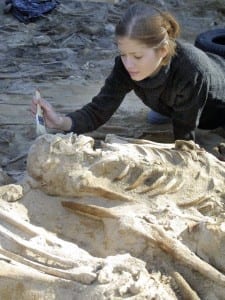Napoleonic soldiers found in mass grave starved to death – Source: The Independent, July 29, 2015

(FILES) File picture dated autumn 2001 shows a researcher examining skeletons of the Napoleonic soldiers discovered in a mass grave on a building site. Burial ceremonies were held at the Antakalnis memorial graveyard 01 June 2003 of remains of 3,000 French soldiers, slain [or more precisely, starved to death] in 1812 as Napoleon Bonaparte’s army fled in defeat from Russia, and finally laid to rest almost two centuries after they died. (Photo credit should read PETRAS MALUKAS/AFP/Getty Images). Source: July 25, 2015 Forbes article (see link at this post) entitled: “Skeletons Of Napoleon’s Soldiers Discovered In Mass Grave Show Signs Of Starvation.”
The opening paragraphs read:
“A longstanding mystery surrounding the deaths of 3,000 soldiers from Napoleon’s army found in a mass grave in Lithuania has been solved.
“The jumbled bones of the men who died on the French leader’s ill fated attempt to march on Moscow in 1812 show signs of starvation, according to archaeologists from the University of Central Florida.
“According to Forbes, buttons found on the site, which was first discovered in Lithuanian capital Vilnius in 2002, show over 40 different regiments were represented from Napoleon’s army as they made their desperate dash back across Europe.”
Why the article is of interest to me
The article caught my eye because of a story about one of my ancestors. My parents were from Estonia; they escaped as refugees from Estonia in 1944 travelling across the Baltic Sea to Sweden each on a separate boat, at the start of the second occupation of Estonia by the Soviet Army during the Second World War. I was born in Sweden after the war.
One of my ancestors on my father’s side was a soldier from Poland who served in Napoleon’s army, which invaded Russia in 1812. After the failure of the Russian campaign, what remained of the army retreated.
Two of the soldiers from Napoleon’s retreating army happened to arrive, on their way back, at a village in Estonia. They married women in the village and settled down at their newfound homes.
The Archaeology News Network article has prompted me to stop, for a moment, and to imagine those times.
1812
In North America, when we think of that era we think of the War of 1812. The defeat of Napoleon in Waterloo in 1815 hastened the ending of the war.
What also comes to mind are two battles that were decisive in bringing to an end the initial American plan to conquer Canada during the War of 1812.
I’ve outlined the story in previous posts:
When Britain Burned the White House: The 1814 Invasion of Washington (2013)
Battle of Chateauguay (1813): one of two great battles that saved Canada
Waterloo
Relevant articles regarding Waterloo include:
Napoleon’s dream died at Waterloo – and so did that of British democrats (Guardian, June 17, 2015)
200 Years After Waterloo, Napoleon Still Wins by Losing (New York Times, June 16, 2015)
Don’t spare the horses: how the Battle of Waterloo became a stage sensation (Guardian, June 18, 2015)

Leave a Reply
Want to join the discussion?Feel free to contribute!